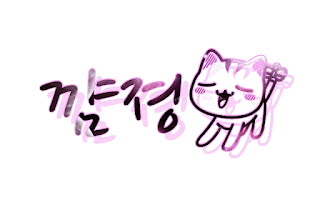 |
| Source |
Korean cursive can be a little tricky to read, especially if you do not have any prior experience with it. Still, don't worry! Here, I'll give you some tips on how to improve your cursive Korean.
Korean Cursive Letters: Learning the Basics
When it comes to Korean writing, the idea of "cursive" may seem somewhat foreign. Unlike the cursive Latin alphabet, the Korean Hangul script doesn't have an official or fixed cursive form, due to its syllabic nature. Writing Hangul in a connected cursive style would make it harder to read, instead of easier. However, Korean does have its form of handwriting or "cursive", which is more of a personal stylistic choice that can make your writing look more natural and flowing.What is Cursive Korean?
In Korean, cursive handwriting is often referred to as 필기체 ("pil-gi-chae" - note text) or 흘림체 ("heul-lim-chae" - spilling/flowing text). And it’s not considered fancy like its Western Latin alphabet counterpart.Korean cursive handwriting is more of a semi-connecting style where the Hangul letters are partially joined. It's not a strict rule-based style like cursive writing in English.
That said, in day-to-day personal writing, most Koreans use either the standard printed form of Hangul or their personal style of cursive or semi-connecting writing.
Ink Calligraphy: The Real Cursive Korean?
Ink calligraphy could indeed be regarded as the original form of Korean cursive writing. If we consider the definition of cursive as "the old way a language was written", then Korean ink calligraphy would fit the bill. It is both old and fancy and requires a lot of skill and practice to master.That said, in day-to-day personal writing, most Koreans use either the standard printed form of Hangul or their personal style of cursive or semi-connecting writing.
Tips to Understand Korean Cursive Handwriting
1. Importance of Proper Stroke Order
Before discussing the cursive style specifically, you should know the proper stroke order of Korean letters. Understanding the correct order will make cursive much more accessible to read.The primary reason is that cursive is written quickly, and it's easy to miss a stroke or two if you are not familiar with the writing style. Thus, it's important to have familiarity with each letter's stroke order.
2. Tips for Various Letters
While each letter has its unique strokes, there are certain tips you can use to read specific letters more easily. Here are some examples:ㅂ
.jpg) |
| Source |
ㅎ
.jpg) |
| Source |
For ㅎ, some people write it with a horizontal line, while others use a vertical line or a slanted line. The lines and circles connecting ㅎ can also cause difficulties in reading.
ㅊ
ㅊ
.jpg) |
| Credit on image |
ㄹ
 |
| Source |
ㅅ
.jpg) |
| Source |
ㄷ
.jpg) |
| Credit on image |
It may look like number 2 in reverse. Or, gapping can occur between the top and bottom stroke of ㄷ when written quickly.
Others examples:
.jpg) |
| Credit on image |
.jpg) |
| Credit on image |
.jpg) |
| Credit on image |
.jpg) |
| Credit on image |
.jpg) |
| Credit on image |
How to Make Your Handwriting More Natural
If you're learning Korean or just want to make your Hangul handwriting look more natural, there are a few tips you can follow.1. Learn Proper Stroke Order
Again, proper stroke order is essential in Korean writing. Learning the correct stroke order for every letter provides a foundation for good penmanship, improves accuracy, and enhances your understanding of Korean handwriting. Familiarize yourself with the stroke order to ensure that your handwriting is legible and connected.2. Compare Fonts
How to write Korean in cursive well? Another tip is to compare different fonts. Write Hangul on your computer using various font styles and then compare them to find one that resembles your handwriting. Doing this exercise will help you study how different fonts and letter shapes can impact the overall look of your Korean handwriting.3, Take an Interest in Korean Cursive Calligraphy
Korean calligraphy is a beautiful art form that may inspire and improve your handwriting. Watching calligraphers on platforms like YouTube will give you a better sense of brush strokes, letter anatomy, and the use of white space. You may not want to practice calligraphy on your own, but exposure to this art can improve your handwriting skills.4. Expand your Vocabulary
Expanding your Korean vocabulary can help better your handwriting. By increasing your repertoire of Korean words, your mind develops a more natural sense of lettering and word formation. Over time, this can help enhance your writing speed and the accuracy of your stroke order.5. Practice Makes Perfect
The more you write, the more comfortable you will become with the shapes and strokes of the Hangul characters.6. Study other Korean handwriting styles
Trying to copy other handwritten styles (likely found by googling 글씨) can be helpful. Don't worry if your handwriting doesn't look quick and flowing; it doesn't have to be to be considered pretty.Last words
Korean handwriting, like any other cursive writing, varies greatly between people. By mastering the correct stroke order and practicing writing as fast as you can, you will improve your Korean cursive handwriting skills. Besides, try to check out different Korean fonts to see how others write their letters. Don't be afraid to experiment and have fun while learning this unique writing style!안녕!
.jpg)
.jpg)